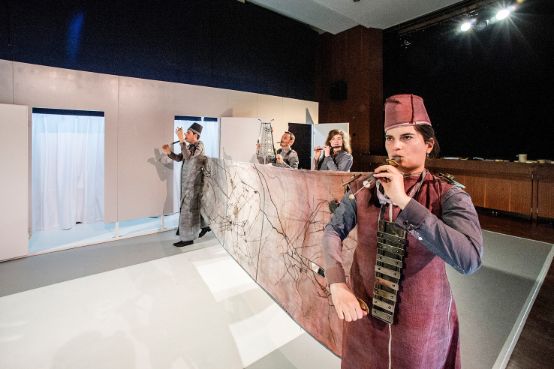Marignano musical-couturistic
On April 14 and 15, the Klangbox ensemble performed its production "XiViX Op. 1515" at the Dampfzentrale in Bern.

Initiated by Pro Helvetia, the event takes place under the name Viavaia series of cultural exchange projects between Switzerland and Lombardy. (We have reported.) One of these is XiViX Op. 1515. The director of the artist platform Klangbox, Pascal Viglino, developed it in collaboration with the Brera Academy of Fine Arts in Milan. The theme chosen was the Battle of Marignano - at a time when the media's interpretative bickering was not yet raging so loudly. Eleven designers and musicians each created a musical-couturistic piece in cross-border groups of two. Director Stefan Hort put these together to create an evening of music theater.
So much for the somewhat exhausting initial situation, where you can't quite shake off the thought that the widest possible range of potential sponsors has been considered. And because the performance bears the subtitle "pour mannequins & ensemble", there is a slight fear of a monstrous war fashion show in which one outlandish musical-textile outfit will try to outdo the previous one.
XiViX Op. 1515 is fortunately a rather quiet evening. Quiet doesn't quite cover it, because sounds constantly accompany the action on stage, are, so to speak, the river on which image after image flows past: often mere noises, rhythms on percussion instruments, short musical fragments, a few phrases from the Marignano song, drums and whistles. Flute sounds. They intensify and then thin out again. At one point, marching music emerges from the loudspeakers, which, played ever more slowly, soon becomes nothing but a clatter. There are only four people, two women and two men, experienced performers, who carry the performance musically and dramatically: Elisabeth de Mérode (flute, voice), Damien Darioli (percussion, flugelhorn), Anja Füsti (percussion) and Pascal Viglino (percussion, conductor).
On the percussive, flute-like and vocal "soundtrack", they create and dissolve images, evoking the turmoil of battle, grandeur and suffering. The individual contributions of the designer-musician pairings could certainly be separated, but one willingly follows the ever-changing associations. Sometimes they seek proximity to historical events, for example when the two men of the ensemble in colorful uniform set pieces engage in a rhythmic duel on the large timpani or when two performers bring the map stretched out between them onto the stage: Territory that has become a matter, an object of dispute. Other scenes hint at a symbolic dimension of the theme: when dozens of crosses are hastily stuck to the wall with adhesive tape, when a tilting figure changes from white to red with a flick of the wrist (a somewhat flat symbolism, however), when the blindness and vanity of war appears as a rigid figure covered in shards of mirror.
At the beginning, it slowly becomes light over a gentle hilly landscape. Distant shots can be heard. Or is it just air being expelled? As the light increases, the landscape reveals itself to be a huge cloth, the hills the bodies of the performers. Later, they stretch out of holes, now visibly operating their flutes, which make these ambiguous noises. We see how an effect is achieved. This principle can be seen again and again over the course of the 70 minutes of the play. It leads to a certain distance - and thus enables reflection. In XiViX Op. 1515 there are no Marignano opinion leaders at work, here you can reflect on the pull of the drums, the bitterness of dying and the hollowness of victory.








